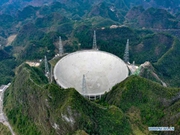

This combination photo shows Jino doctor Bai Lalei (C) giving medical treatment to villagers on Jino Mountain in 1977 (above, file photo); and Jino medical workers Zhou Yifang (1st L) and Zhou Jing (2nd L) giving intravenous injection for a patient at a local hospital in Jino Ethnic Township on Jino Mountain, Nov. 20, 2018 (below, photo by Lin Yiguang). With a population of slightly over 20,000, the Jino people had only been officially acknowledged in 1979 as an independent ethnic group of China. Until 1949, most of them had lived for generations in primitive mountain tribes in southwest China's Yunnan Province. Over the four decades since it embraced the reform and opening-up policy, China has spared no effort to support ethnic groups with smaller populations. Life on Jino Mountain, where most Jino communities are located, saw positive changes in parallel with improvements in local politics, economy, technology, education, culture, health care, ecology, ethnic development and other social undertakings. Just like its 55 ethnic brethren, the Jino people also benefit from China's reform and opening-up in seeking a prosperous life. In Jino Ethnic Township on the Jino Mountain, residents now have direct access to road, water, electricity, TV and radio, as well as the mobile network. Ninety percent of the residents have moved into new houses. Most residents own motorcycles and tractors, and some of them have purchased cars. More people have increased their income by selling local specialty products via the internet, whereas in the past, doing business was perceived as a shame. Currently, the primary education in Jino Ethnic Township achieved 100 percent coverage for all school-age children. More than 99 percent of residents have joined the rural cooperative medical insurance programme. The Jino ethnic culture undergoes protection and inheritance: the great drum dance of the Jino people has been listed as one of China's national intangible cultural heritages. (Xinhua)
 |  |

 Award-winning photos show poverty reduction achievements in NE China's Jilin province
Award-winning photos show poverty reduction achievements in NE China's Jilin province People dance to greet advent of New Year in Ameiqituo Town, Guizhou
People dance to greet advent of New Year in Ameiqituo Town, Guizhou Fire brigade in Shanghai holds group wedding
Fire brigade in Shanghai holds group wedding Tourists enjoy ice sculptures in Datan Town, north China
Tourists enjoy ice sculptures in Datan Town, north China Sunset scenery of Dayan Pagoda in Xi'an
Sunset scenery of Dayan Pagoda in Xi'an Tourists have fun at scenic spot in Nanlong Town, NW China
Tourists have fun at scenic spot in Nanlong Town, NW China Harbin attracts tourists by making best use of ice in winter
Harbin attracts tourists by making best use of ice in winter In pics: FIS Alpine Ski Women's World Cup Slalom
In pics: FIS Alpine Ski Women's World Cup Slalom Black-necked cranes rest at reservoir in Lhunzhub County, Lhasa
Black-necked cranes rest at reservoir in Lhunzhub County, Lhasa China's FAST telescope will be available to foreign scientists in April
China's FAST telescope will be available to foreign scientists in April